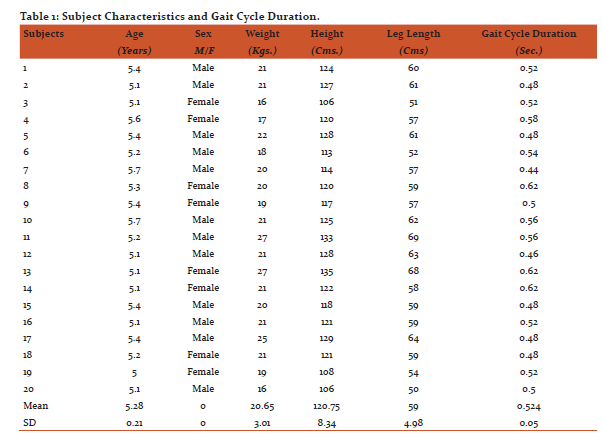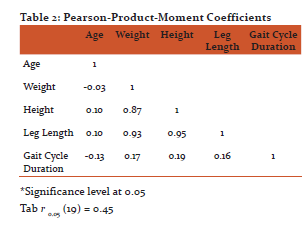IJCRR - 9(6), March, 2017
Pages: 40-43
Date of Publication: 31-Mar-2017
Print Article
Download XML Download PDF
Gait Cycle Duration: A Determining Factor of Gait Maturity in Children
Author: Ikram Hussain, Syed Anayat Hussain
Category: Healthcare
Abstract:Aim: To explore one of the temporal characteristic of running gait (Gait Cycle Duration) in children and determine its relationship with the selected body characteristics
Methodology: Twenty school going children of 5 years age consisting of both genders were selected for the study. To obtain the required data, an experimental setup was designed consisting of caliberated running path and a cannon camcorder Legria SF10 operating at shutter speed of 1/2000 and frame rate of 50 Hz. The obtained video data was analyzed using Silicocoach7 motion analysis software. The statistical analysis was done by SPSSv 17.0 to determine the relationship of gait cycle duration with the selected body characteristics.
Results: No significant relationship was found between the gait cycle duration and body characteristics, however a striking feature got extracted that the gait cycle duration of 5 years old children was shorter than that of adults.
Conclusion: The results concluded from the study could be of great use to clinicians to assess the gait maturation or abnormality in the gait of children. Further, the changes in the gait cycle duration could reflect improvement in gait over time..
Keywords: Body Characteristics, Gait Cycle Duration, Motion Analysis
Full Text:
INTRODUCTION
Gait is the manner in which we move our body across the environment. It is a complex phenomenon which consists of alternating rhythmical swinging forward of the leg and foot strike involving the coordination of almost all the joints and muscles of the body (Slaton, 1984). In case of children, immature control of posture and gait results in unsteadiness in locomotion and thereby having large stride-to-stride fluctuations and frequent falls (Breniere and Brill, 1988). By the time children grow in age (approx. above 3-years old), their gait tends to become relatively mature and a more stable walking/running pattern is observed (Sutherland, Olshen, Biden and Wyatt, 1998). Even after this age, development of neuromuscular control and locomotor function continues. With maturation, experience and motor learning, movements and postural adjustments in children tend to become automated to meet the new demands and situations (Scott, 1967). However, the criteria applied in determining the mature gait is rather controversial. Many factors like stride and step length, stride width, foot placement angle, cadence etc have been used to measure children’s gait. One such factor which has been taken into consideration in current study is “gait cycle duration”.
Statham and Murray suggest that gait cycle duration during free walking is shorter in pre-school children than in the adult and that cycle duration tends to lengthen as age increases (range; 0.68 sec at 1 years of age to 0.96 sec at 5 years of age). However, little information is available about the variability of gait characteristics (gait cycle duration) with growth and maturation and same has been tried to find out in this study, if the subject’s changing characteristics (age, sex, weight, height and leg length) is having significant influence on gait cycle duration. Thus, the present study will provide an insight into the development of neuromuscular control in children. Also, it will help in removing the size related variability in results of various studies where subjects of different body characteristics are taken into consideration through normalization of gait parameters.
MATERIALS AND METHODS:
Subjects
A group of 20 children (5 years old) containing both genders participated in this study. Before examining the subjects, the consent from their parents was received. Children who had any disorders likely to affect gait were excluded. The mean and standard deviation (SD) of their age (yrs), body height (cms) and body weight (kgs) were 5.28±0.21, 120.75±8.34 and 20.65±3.01 respectively.
Protocol
The required gait data was obtained using a Legria SF10 canon camcorder operating at shutter speed of 1/2000 and frame rate of 50 Hz, positioned perpendicular to sagittal plane on the left side of the subject at a distance of 8.5 meters from the mid of the calibrated running line/axis. The subjects ran on the provided calibrated running line/axis for about 10 meters at fast speeds. The subjects were given three trials to trace out the best which would be considered for analysis. The filming procedure took not more than 15 minutes. After filming, each child was asked to remove his or her shoes and socks. Then, measurement of height, weight and the distance from the right anterior iliac spine to the floor (leg length) was taken.
After obtaining the required video data, the recorded videos were carefully viewed and the best performance clips were extracted for analysis which was done by Siliconcoach7 motion analysis software. The “gait cycle duration” was assessed to determine its relationship with the selected body characteristics of a child. The gait cycle durations were recorded from heel strike to successive heel strike of the same foot.
Pearson product-moment correlation coefficients were calculated to determine the strength of relationship between gait cycle duration and sex, age, height, weight and leg length.
RESULTS
Table 1 presents individual characteristics and average cycle durations for each subject. The age ranged from 5 to 5.7 years, height from 106 to 135 cms, weight from 16 to 27 kgs and leg length varied from 50 to 69 cms. Individual mean cycle durations ranged from 0.44 to 0.62 sec with an overall sample mean cycle duration of 0.52 sec ± 0.05 sec

The subjective notations I made during filming procedure suggest that most of the children were feeling somewhat hesitating and uncomfortable and were showing extra cautious attitude. Also few subjects did not maintain the proper swing of their arms during running. Inspite of this, no relationship existed between postural attitudes or upper extremity position and the duration of corresponding gait cycles.
Table 2 represents the correlation of gait cycle duration and the selected individual characteristics. I found that no significant relationships between cycle duration and subject characteristics.

DISCUSSION
The mean gait cycle duration of 5 years old children as determined through the current study is 0.52 sec, which is shorter in comparison to adults (Statham and Murray, 1971). The reasons for this is however not clear, but Statham and Murray suggest that;
- The shorter cycle duration or increased cadence could be an attempt by children to decrease the lateral displacement of their high centre of gravity. Murray had found that, faster gait speeds in adults decreased the lateral displacement of centre of gravity, and then as such as child grows older and centre of gravity gradually descends, the gait cycle duration also lengthens. Our results also seem to support this hypothesis.
Another explanation for shorter gait cycle duration in children as compared to adults is reported by Saunders and his associates who suggest that;
- The shorter cycle duration could be the lack of acquisition of six determinants of mature gait in children (pelvic tilt, pelvic rotation, knee flexion at mid-stance, foot and knee coordination at heel and toe-off and lateral displacement of pelvis). If this could be the reason, then cycle duration should lengthen to same extent as that of adult by the time a mature gait is achieved. Sutherland and his associates also suggest the same. From their data, it was reported that cycle duration rapidly increased during initial periods of walking/running until 3 years of age. Then after, this increase continues but at a slower rate. This suggests that cycle duration is directly related with acquisition of gait determinants.
Although no significant relationship was determined between gait cycle duration and body characteristics of children in our study, yet relationships may exist if some other age group is considered or a larger sample is studied. If the significant relationship is determined, it could be of use to clinicians to assess further maturity or abnormality in gait in childhood. Changes in gait cycle duration could reflect improvement in gait over time.
CONCLUSIONS
The mean running gait cycle duration in 5 year old children is shorter than adults; many reasons have been put forth as discussed in the content of discussions. The results as depicted by our study are consistent with the results of other studies showing a trend of increasing of gait cycle duration with age. However, further studies need to get completed in order to determine the feasibility of using gait cycle duration as a tool for measuring gait maturity or abnormality in clinical setting.
ACKNOWLEDGEMENT
The authors acknowledge the immense help received from the scholars whose articles are cited and included in references of this manuscript. The authors are also grateful to authors/ editors/ publishers of all those articles, journals and books from where the literature for this article has been reviewed and discussed.

References:
- Breniere, Y., and Brill, B. (1988). Why do children walk when felling down, while adults fell down in walking? Computes Rendus Academie Sciencies III, 307: 617-662.
- Sutherland, D. H., Olshen, R. A., Biden, E. N., and Wyatt, M. P. (1988). The development of mature walking. Oxford, UK: Mackieth.
- Scott, L. (1967). Child development: An individual longitudinal approach, New York, NY, HoH, Rinehart and Winston General Book, 20-144.
- Statham, L., and Murray, M. P. (1971). Early walking patterns of normal children. Clinical Orthopedics and Related Research, 79: 8-24.
- Slaton, D. S. (1984). Gait cycle duration in 3-year-old children. Physical Therapy, 65: 1, 17-22.
- Saunders, J. B., Inam, V. T., and Eberhart, H. D. (1953). The major determinants of normal and pathological gait. Journal of Bone and Joint Surgery (Am), 35: 543-558.
|






 This work is licensed under a Creative Commons Attribution-NonCommercial 4.0 International License
This work is licensed under a Creative Commons Attribution-NonCommercial 4.0 International License